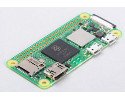

Raspberry Pi Zero W takes a SiP of Cortex-A53
source link: https://linuxgizmos.com/raspberry-pi-zero-w-takes-a-sip-of-cortex-a53/
Go to the source link to view the article. You can view the picture content, updated content and better typesetting reading experience. If the link is broken, please click the button below to view the snapshot at that time.
Raspberry Pi Zero W takes a SiP of Cortex-A53
Oct 28, 2021 — by Eric Brown
134 views
 The $15 “Raspberry Pi Zero 2 W” updates the tiny Zero W SBC with a SiP packaged, 1GHz, quad -A53 BCM2710A1 SoC that is up to five times faster. The Zero 2 W upgrades the WiFi/BT module to pre-certified 802.11n with BT 4.2.
The $15 “Raspberry Pi Zero 2 W” updates the tiny Zero W SBC with a SiP packaged, 1GHz, quad -A53 BCM2710A1 SoC that is up to five times faster. The Zero 2 W upgrades the WiFi/BT module to pre-certified 802.11n with BT 4.2.
Raspberry Pi has launched an updated version of the $10 Raspberry Pi Zero W, which arrived in early 2017 as a wireless-enabled alternative to the similarly petite, $5 Raspberry Pi Zero. The $15 Raspberry Pi Zero 2 W maintains the 65 x 30mm footprint and ports of the W, but advances from the 1GHz, ARM11-based Broadcom BCM2836 to a SiP-packaged Broadcom BCM2710A1 with 4x Cortex-A53 cores.
(click image to enlarge)
The BCM2710A1 is much like the BCM2837 found on the Raspberry Pi 3 but is clocked to 1GHz instead of 1.2GHz. Using the multi-threaded sysbench benchmark, the Zero 2 W “is almost exactly five times faster” than the Zero boards, wrote RPi CEO Eben Upton in the announcement.
The other feature change is that the 2.4GHz 802.11 b/g/n equipped wireless module advances from Bluetooth 4.0 to 4.2, once again with an onboard antenna. As with recent Pi boards, the module is shielded and pre-certified to FCC standards.
— ADVERTISEMENT —
The VideoCore IV GPU is unchanged. There is support for OpenGL ES 1.1, 2.0 graphics, 1080p30 decode with H.264 and MPEG-4, and 1080p30 encode with H.264.
Other features remain the same, with 512MB LPDDR, a microSD slot, and micro-USB OTG and mini-HDMI ports. Once again, there is a HAT-compatible, unpopulated 40-pin GPIO header, composite video/audio and reset headers, and a MIPI-CSI camera connector, upgraded to CSI-2.
Raspberry Pi Zero 2 W (left) and new RPi Zero 2 PSU(click images to enlarge)
The -20 to 70°C tolerant SBC derives 5V/2.5A rather than 5V/1.5A power from the micro-USB port. To power the board there is a new $8 RPI Zero 2 power supply that closely resembles the Raspberry Pi 4 PSU, but with a micro-USB interface instead of Type-C. This also works with the RPi 3B and 3B+.
Of all the Pi models, Upton takes the greatest pride in the launch of the original Raspberry Pi Zero, which managed its groundbreaking combination of size, power, features, and low price by using a package-on-package (PoP) form factor, in which the RAM sits directly on top of the SoC. The Zero inspired a host of minimalist imitators among Linux hacker boards, such as the even smaller Orange Pi and NanoPi Neo boards.
A PoP design is not possible in this tiny form factor given the size requirements of a quad-core SoC, so RPi Zero 2 W designer Simon Martin instead created a Raspberry Pi RP3A0 system-in-package (SiP) in which the SoC and RAM dies are more closely integrated. To handle the increased heat, the Zero 2 W uses thick internal copper layers to conduct heat away from the processor. This increases the weight, although Raspberry Pi does not say by how much.
RPi Zero 2 W RP3A0 SiP package diagram (left) vs. PoP package used on earlier Zero boards(click images to enlarge)
As before, the base price is only meaningful (for most applications) for those who already own the industry standard cables required by the earlier Zero boards. As described in this Wired hands-on review, that includes a mini-HDMI cable or adapter and a micro-USB to USB A adapter, which together cost about $8. If you do not want to use the cable to power the Zero 2 W via a PC, you will need the $8 Zero 2 PSU or something similar for a total of about $31, including the Zero 2 W. Other peripherals include a $5 case, a $7 keyboard/mouse, and more.
The Zero 2 W, which has promised production availability through 2028, “isn’t immune to the current global semiconductor shortage,” wrote Upton. “We expect to ship roughly 200k units this calendar year, with a further 250k to follow in the first half of 2022.”
The Zero and Zero W, which together have sold nearly 4 million units, continue to sell at their original prices. Yet, Upton notes that these SBCs are also experiencing supply constraints, which he hopes will be resolved in 2022. Last week, the chip shortage motivated Raspberry Pi to boost the price of the RPi 4 with 2GB RAM up to $45 and bring the discontinued RPi 4 1GB back to life at $35.
Further information
The Raspberry Pi Zero 2 W is available for $15 (or £13) plus about $8 in cables and $15 for the new Zero 2 W PSU, if you do not already own them. The SBC is available now in the UK, EU, US, Canada, and Hong Kong, with more countries coming soon, starting with Australia and New Zealand in November. The Zero 2 W is free to MagPi subscribers.
More information may be found in the announcement and product page.
Recommend
About Joyk
Aggregate valuable and interesting links.
Joyk means Joy of geeK